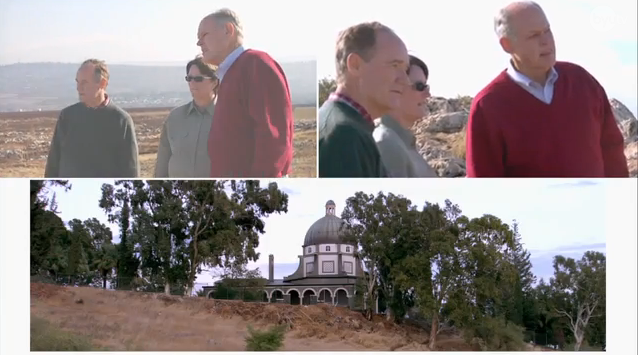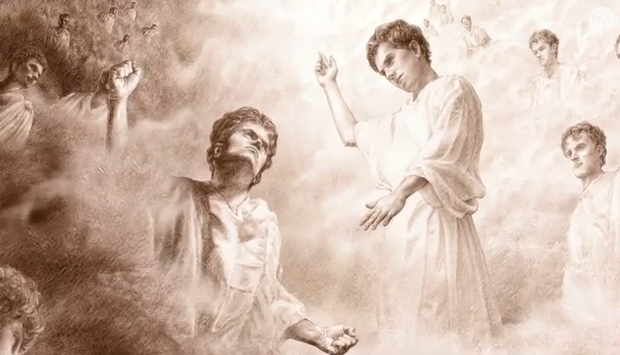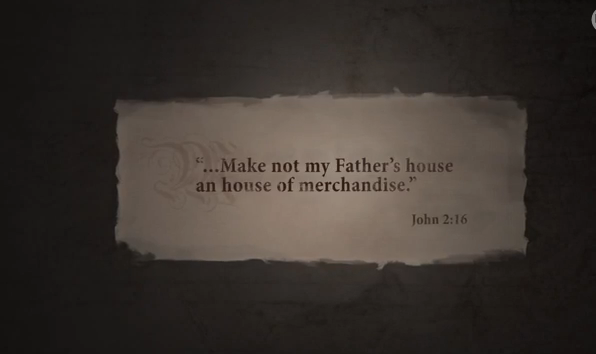Who is this ancient figure who stands at the crossroads of history? Is He a great teacher? A revolutionary? Prophet? Or is He indeed the divine Son of a divine Father? The literal Savior of the world? In struggling to answer this question, many scholars dismiss the divine and separate the Jesus of history, the mortal man, from the Jesus of faith, the Son of God. Today, Latter-day Saint scholars seek to join history and faith, scholarship and modern revelation, to reach a more complete understanding of who Jesus was, and is.
Within the pages of the Old Testament, the phrase, “Thus saith the Lord.” appears more than 400 times as prophets quote their God. Moses utters these words to Pharaoh. Jeremiah speaks them to all of Jerusalem. And yet, the expression is nowhere to be found in the New Testament. Instead, the Carpenter’s Son simply declares, “Verily, I say unto you.” From the Sermon on the Mount to the miracle at Lazarus’s tomb, the God of Israel speaks for Himself.
ANDREW SKINNER: Since the late 18th century, some New Testament scholars have engaged in what they refer to as the quest for the historical Jesus, what Jesus really said and really did. Their research has taken them to the pages of history, theology, archaeology, and philology—which is the study of ancient languages. Generally speaking, these same scholars have tended to reject everything which mentions the supernatural, supports divine authority, or tells us the specific way we should live our lives.
JOHN S. TANNER: This is a marvelous location above this northern part of the Sea of Galilee where we can see so many of the events that took place in Jesus’ life. I think for me the first thing I try to do is orient myself.
S. KENT BROWN: You come around the corner of the Sea of Galilee, to the northeast corner. There lies Bethsaida.
GAYE STRATHEARN: And that’s the home of Peter, Andrew, and Philip. That’s where they were born.
JOHN S. TANNER: That’s a kind of tip, isn’t it, of the lake, right here, the tip?
S. KENT BROWN: Yes.
GAYE STRATHEARN: Yeah, the modern archaeological dig for this site is a little bit further in from the sea. Once—in Jesus’ day—the sea went out much farther.
 S. KENT BROWN: The river comes into the Sea of Galilee and actually divides the territories. On the east side was Herod Philip, one of the surviving sons of Herod the Great. On the west side was the territory of Herod Antipas, who was the ruler of Nazareth and other places around here. He’s the ruler under whom Jesus grew up.
S. KENT BROWN: The river comes into the Sea of Galilee and actually divides the territories. On the east side was Herod Philip, one of the surviving sons of Herod the Great. On the west side was the territory of Herod Antipas, who was the ruler of Nazareth and other places around here. He’s the ruler under whom Jesus grew up.
GAYE STRATHEARN: He’s also the ruler, isn’t he, that put John the Baptist to death.
S. KENT BROWN: That’s correct. After you come across the Jordan River, where it empties into the sea, you run into Capernaum, that’s the first town.
GAYE STRATHEARN: Capernaum was a really, really important place for the Galilean ministry. Capernaum was Jesus’ own city while he was in this ministry. So although He would travel all over the Galilee, He would always come back to Capernaum. And so that’s His home.
JOHN S. TANNER: So He grew up in Nazareth over here, but really this was His adopted home town, Capernaum. What’s after Capernaum, is that where we get to the Hill of the Beatitudes?
S. KENT BROWN: That’s right. There’s a hill that rises up, the traditional spot of the Sermon on the Mount, right?
GAYE STRATHEARN: Right, right. So it’s just this little hill directly in front of us. And that’s the traditional site where Jesus gave the Sermon on the Mount.
JOHN S. TANNER: Now there’s a little church there commemorating that Sermon on the Mount.
JOHN W. WELCH: One of the reasons, of course, that people have a hard time understanding the Sermon on the Mount in a historical setting, is trying to figure out where it came from—how early was it, does it really reflect a speech that Jesus gave as a coherent, unified whole, or is it a random collection of sayings compiled perhaps by Matthew at a much later date? There’s no great consensus among New Testament scholars about the dating of the Sermon on the Mount. Some see it quite late. But others are beginning to see it as at least a pre-Matthean text, a text that Matthew found and used and incorporated into his Gospel. This makes sense, because a fifth of the words used in the Sermon on the Mount are never used by Matthew again. These words are not Matthew’s words, they are not his vocabulary. And Matthew even includes some parts of the Sermon on the Mount that would be rather puzzling. He doesn’t stop to explain what they mean.
For example, the saying that we should not cast our pearls before the swine or give our holy thing to the dogs, seems to be a very important requirement of secrecy or sacred treatment of the things that are being taught, but Matthew never elaborates on that, something that he would have done if he had created this text as an introduction to the teachings and ministry of Jesus and His gospel.
GAYE STRATHEARN: We notice that the sermon in Luke is very different from the sermon in Matthew. And scholars would generally say that Luke’s sermon, which is much shorter than Matthew’s, it probably reflects the more historical sermon that Jesus gave. If that’s your assumption, and then you come and say, well what happened here with Matthew, then it’s much larger, it’s much more detailed, it’s much more pronounced in many ways than in Luke’s, so how did we get from a Lukan version of the sermon, to a Matthean version, and so the Matthean version must have been made up, put together by later Christians to justify their teachings and things like that, so that Jesus never said the sermon in Matthew’s account. Well for a Latter-day Saint that’s untenable, right. Because when we open 3rd Nephi, the account that Jesus gives, the sermon there is much closer to the Matthean version than it is to the Lukan version, and there we know that it’s given as a single sermon rather than just a lot of sayings put together.
JOHN S. TANNER: The message and the miracles of Jesus have had a profound impact on the history of the world. But did He actually do and say the things that the gospel writers record? Can their words be trusted? As you know, much modern scholarship disputes this and is skeptical. But when the Book of Mormon is brought to bear on the question, we have good reason to be skeptical of the modern skepticism, because the Book of Mormon confirms in most details the historical accuracy of the portrait of Jesus that we see in the New Testament.
GAYE STRATHEARN: Well that’s exactly right. In the Book of Mormon, Jesus is going to heal the sick, give sight to the blind, He’s going to ordain apostles and He’s going to establish a church. And perhaps most importantly, we have the physically resurrected and glorified being appearing to the inhabitants of the New World, just as He appeared to His disciples in the Old World.
JOHN S. TANNER: When one compares what Jesus says and does in the New Testament with what He says and does in the Book of Mormon, the record is just overwhelming that He is in fact the Messiah, just as both records portray Him to be. And they’re mutually reinforcing in this way.
GAYE STRATHEARN: And so a good way to appreciate this is to take Jesus’ teachings and have a careful study in both texts. And the Sermon on the Mount provides a powerful case study for such a comparison.
JOHN S. TANNER: Indeed it does.
GAYE STRATHEARN: Oftentimes, the similarities between the sermon in Matthew and 3rd Nephi have been seen as evidence to show that the Book of Mormon didn’t have anything to offer, and it was just a copy of the King James version. A number of years ago, a very, very fine New Testament scholar, Krister Stendahl, came here to BYU, and he examined the Sermon on the Mount in Matthew with the Sermon at the Temple. Now I don’t agree with all of his conclusions that he came through [with], but one of the things that he said I think was just pivotal, even for our understanding as Latter-day Saints, is that in the Sermon on the Mount in Matthew, Jesus is teaching as a rabbi. He’s reinterpreting the Law of Moses to apply to His day. And He says in that respect He’s not that much different from many of the other rabbis of the 1st century. But, he says, when we come to the Sermon at the Temple in 3rd Nephi, Jesus is speaking as the Messiah. Now that’s a very significant difference from a non-Latter-day Saint point of view.
And he came to that conclusion by a very, very careful reading of the two texts. Not just the similarities, but where they differ. And although the differences are small and could be easily overlooked if you’re just reading quickly, when you have a careful reading of these texts, these stand out and they’re significant.
So, some of the places that he saw significant differences— they all come to one phrase, this little phrase, Come unto me. He says in verses 18 through 20—notice how many times we have that phrase, Come unto me: “For verily I say unto you, one jot nor one tittle hath not passed away from the law, but in me it hath all been fulfilled. And behold, I have given unto you the law, and the commandments of my Father, and that ye shall believe in me, and that ye shall repent of your sins and come unto me with a broken heart and a contrite spirit. Behold, ye have the commandments before you, and the law is fulfilled. Therefore come unto me and be ye saved” (3 Nephi 12:18–20).
So we get this phrase that’s coming on. If we jump down further, where in the Matthew account it talks about if you have aught against your brother to leave your gift at the altar and then go and make it right and then come back, the altar here has been replaced in verse 23: “Therefore, if ye shall come unto me, or desire to come unto me, and rememberest that thou—thy brother hath aught against thee, go thy way unto thy brother and first be reconciled unto thy brother, and then come unto me with full purpose of heart, and I will receive you” (3 Nephi 12:23–24).
Jesus has replaced the altar as the center of salvation. That’s a huge difference between what we find in Matthew and what we find in 3rd Nephi.
And the last one, perhaps really important, is in Matthew, “Be ye therefore perfect, even as your Father in Heaven is perfect (Matthew 5: 48) Whereas in the 3rd Nephi account, “Therefore, I would that ye should be perfect, even as I or your Father who is in heaven is perfect” (3 Nephi 12:48). Jesus now is equating Himself with perfection, in a way that he couldn’t do so much in Matthew, because He hadn’t completed His mission, He hadn’t gone through the Atonement and the resurrection, like He has in 3rd Nephi. So this is a glorified being in 3rd Nephi, and that’s reflected then in the sermon, that’s not reflected in the Matthew account. So I think that there are very, very significant differences between the two. They’re not just a cut and paste of the Matthew version.
JUAN HENDERSON: When the Savior finished delivering His sermon that the Father had commanded Him, to the ancient Nephites, He turned to them and he said, Please, He says, I perceive that you want me to do the miracle that I performed in Jerusalem. And so He said that they had sufficient faith to do this. And so He commanded them to bring forth their sick and their lame and so forth. And in the scriptures it says that they had all manner of sicknesses, and Jesus healed them all. This is a powerful testimony, not only in word but in deed, that the Bible account of what Christ did amongst his brethren of healing and so forth, the Book of Mormon is a second witness that He actually did speak those words, and actually did do the healing that the Bible testifies that He did.
S. KENT BROWN: A prominent biblical historian has asked, what is the meaning of the Sermon on the Mount? This is a question that Christianity continues to address. And over the centuries, theologians have offered a wide range of answers. The principal reason that the Sermon on the Mount remains a sealed text to many is the problem of discerning what pulls this all together? Does the sermon have a single unifying theme or logic, or is it a haphazard collection of disjointed sayings?
GAYE STRATHEARN: Yes, it’s to this question I think that the Sermon at the Temple in the Book of Mormon provides clues to a most remarkable answer.
S. KENT BROWN: I agree, Gaye. The Sermon at the Temple gives evidence that the two sermons are actually temple texts, containing allusions to and connections to the most sacred teachings and central celebrations of ancient Israelite worship.
ANDREW SKINNER: Almost everything in the Sermon on the Mount can be seen in the context of the temple. And this is particularly true with the Lord’s Prayer, which is part of the Sermon on the Mount. Jesus is re-emphasizing to His disciples how they can and should pray, and the content of the prayers, what kinds of things ought to be included in our most heartfelt expressions to our Father in Heaven. He emphasizes again to the disciples that they do have a Heavenly Father, “our Father which art in heaven,” which is an important concept linked to the temple. We after all desire through the temple to enter God’s presence.
And so what we come to understand again is that Jesus was giving the disciples a specific understanding of what happens in the temple, and thus the way that they should conduct their lives.








